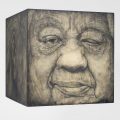By Grace Aldridge Foster

“Nine to Five” by Josh Kline, 3D-printed sculptures in plaster, ink-jet ink, and cyanoacrylate; janitor cart, 2015. This sculpture is in the National Portrait Gallery exhibition “The Sweat of Their Face.” (Image Courtesy of the artist)
On a recent Saturday morning, 15 strangers gathered in “The Sweat of Their Face” exhibition at the Smithsonian’s National Portrait Gallery. They were there to look—and to write.
The group included people from all over the Washington, D.C. region. Some were published authors, others beginning writers. With pencils and clipboards in hand, they stood around Josh Kline’s 3-D printed sculpture “Nine to Five.”
Literary host Willona Sloan instructed the group to walk slowly all the way around the sculpture, observing it closely. After a few minutes of thoughtful silence, the group began to talk.
Several people called it “creepy” or “gruesome,” and it’s no mystery why. The sculpture depicts a custodian’s cart, on which a series of dismembered body parts—a head, a foot and four hands—lay jumbled up with cleaning products. While most people in the group initially reacted with discomfort or confusion, their comments soon took a turn toward tenderness and intimacy.

Portraiture can spark more than just your imagination; portraits can tell us a story about someone’s life. “Strike a Prose” is the first interactive creative writing program for adults at the National Portrait Gallery.
Nearly everyone in the group felt a personal connection. Someone recalled a custodian from work, while someone else remembered the summer she worked cleaning houses. Others thought of their grandmothers who had worked as “cleaning ladies.”
Then, the group began noticing minute details that likely escape the average viewer. Three of the four hands in the sculpture are left hands; one is a right hand. The word “nice” is barely visible inside one of the hollow left hands. The head and hands were the original machine, someone pointed out. Everyone nodded in agreement.
Then Slone offered a prompt: “Relate one of your past jobs or experiences to one of the works of art. How was your experience similar or different to what is depicted in the portrait? How did the experience shape you and change or affect your life? What did you learn from the experience?”
The workshop is part of a new museum program called “Strike a Prose.” For the past year, each time the National Portrait Gallery has opened a new special exhibition, it offers six corresponding workshops, designed and guided by a professional writing facilitator.
“Strike a Prose” also allows participants to enter the museum before it officially opens. The galleries are quiet and still, giving the world-class artworks a sense of intimacy and peace.

“Lathe Operator Machining Parts for Transport Planes at the Consolidated Aircraft Corporation Plant, Fort Worth, Texas,” by Howard R. Hollem, digital inkjet print from color transparency, 1942. This photograph is in the National Portrait Gallery exhibition “The Sweat of Their Face.” (Image courtesy Prints and Photographs Division, Library of Congress)
Sloan designed this particular workshop to focus on the 20th- and 21st-century portions of the exhibition, which contains images of workers dating back to the 18th century.
Beth Evans, a member of the National Portrait Gallery’s Education Department, offered an overview of the exhibition, which is on view through Sept. 3.
“It’s difficult to find portraits of workers because oftentimes they’re nameless, they’re faceless, we don’t always think about them, and yet they’re very much a part of us. They’re a part of our family histories,” Evans says. “Take a minute to think: Who are these people? Why are we seeing them here in this exhibition? What can we learn about them? What are the stories being told?”
Sloan uses classic techniques that many might remember from literature classes in school, but the methods are adapted to the setting and to adult learners who possess a variety of skills and confidence levels.

“Almond Poling Crew During Harvest Near Lost Hills, Ca. September 16, 2009,” by Sam Comen (born 1980) Archival pigment print, 2009. This photograph is in the National Portrait Gallery exhibition “The Sweat of Their Face.” (Image courtesy of the artist)
Briana Zavadil White, student and teacher programs manager at the National Portrait Gallery, says the idea for “Strike a Prose” stemmed from programming the museum was already doing with students and teachers.
“We like all of our programs to add a layer to the experience of looking,” White explains. “We know we have a creatively engaged audience, and we are always thinking about what could add to their experience. These workshops are not just for writers, but for all adults wanting to engage with portraiture beyond looking.”
As portraiture, in general, is deeply personal, the decision to pair writing with portraiture is an obvious one, White explains.
“You can’t help but wonder about a person when you look closely at his or her portrait,” White says. “Where did they come from, where are they going? … What do the pose, expression, objects, and setting say about the individual represented? What is the purpose of the portrait?”

“Alma Sewing,” by Francis Hyman Criss (1901–1973) Oil on canvas, ca. 1935. This painting is in the National Portrait Gallery exhibition “The Sweat of Their Face.” (Courtesy High Museum of Art, Atlanta)
Because of the success of “Strike a Prose,” White says they are getting ready to introduce a new workshop series, “Drawn to Figures.” The general premise is the same.
“The program will use the images in our collection as inspiration for drawing,” she says. “Stay tuned!”
The next series of “Strike a Prose” workshops will take place in a new special exhibition at the National Portrait Gallery, “UnSeen: Our Past in a New Light, Ken Gonzales-Day and Titus Kaphar.” The workshops will be held on April 20 and 21, and May 4, 5, 11 and 12. Registration is available at npg.eventbrite.com.





